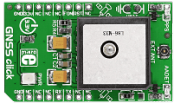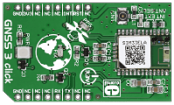|
|
| |
|
 | Search: |
|
|
|
|
|
 |

|
|
Determine your current position with GNSS 5 click. It carries the NEO-M8N GNSS receiver module from u-blox. GNSS 5 click is designed to run on a 3.3V power supply. The click communicates with the target microcontroller over I2C or UART interface, with additional functionality provided by the following pins on the mikroBUS™ line: RST, INT, PWM. |
|
|
|
|
 |

|
|
GNSS click carries Quectel’s L86 GNSS module with a patch antenna along with an external antenna connector. GNSS stands for Global Navigation Satellite System, an umbrella term that describes both the United States GPS and the Russian GLONASS global positioning systems. Excluding its wider applicability, the L86 module is similar to the L80 module (used on GPS3 click). It includes the same set of technologies: automatic prediction of orbits from internally stored data, adaptive adjusting of on/off time to balance between positioning accuracy and power consumption etc. The board uses a 3.3V power supply. |
|
|
|
 |

|
|
GNSS2 click carries Quectel's L76 module and an SMA antenna connector. GNSS stands for Global Navigation Satellite System, an umbrella term that describes both the United States GPS and the Russian GLONASS global positioning systems. The L76 module integrates performance-enhancing Quectel technologies. It can automatically predict satellite orbits from data stored in its internal flash (EASY technology) and it can adaptively adjust its on/off time to balance between positioning accuracy and power consumption (AlwaysLocate technology). GNSS2 click also features a voltage translator. Using the onboard jumper you can switch both the power supply and logic levels from 3.3V to 5V. |
|
|
|
 |

|
|
GNSS3 click carries SIMCom's SIM33ELA standalone GNSS module with an integrated antenna (as well as a connector for an external one). GNSS stands for Global Navigation Satellite System, an umbrella term that describes both the United States GPS and the Russian GLONASS global positioning systems. The SIM33ELA module has MTK's high sensitivity navigation engine. It features EPO orbit prediction, AGPS and SBAS ranging (WAAS, EGNOS, GAGAN, MSAS). GNSS3 click communicates with the target MCU through mikroBUS UART pins (RX, TX), with additional functionality provided through RST and INT pins. The board uses a 3.3V power supply. |
|
|
|
 |
|
|

